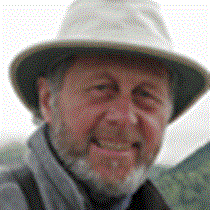there is a kind of larke here that much resembles the bird called the oldfiled lark with a yellow breast and a black spot on the croop; tho' this differs from ours in the form of the tail which is pointed being formed of feathers of an unequal length; the beak is somewhat longer and more curved and the note differs considerably.
So wrote Meriwether Lewis on June 22, 1805 while he, his co-leader William Clark and their intrepid party traveled in search of a route across North America to the rich resources of the northwest and the Pacific Ocean. They eventually arrived at the mouth of the mighty Columbia River, where we began this second part of our journey. Lewis was describing specimens that he collected and which would later be named the Western Meadowlark. He was astute enough to recognize the subtle differences between this bird - then new to science - and the Eastern Meadowlark with which he was very familiar.
We watched in vain for this species today as we cruised up-river through the spectacular Columbia Gorge and rode a comfortable coach from Hood River to The Dalles. A stop at Rowena Lookout, high above the now-tamed river, was one of the many highlights of our venture back into history, and put us right into the grassland and Ponderosa pine habitat of the meadowlark. Also here was Lewis' Woodpecker, another of the many species of birds, plants and mammals that Lewis and Clark added to our scientific inventory. The woodpecker we saw, and a strange one it is. Gaudily colored in pink, black, green and white, it flies like no other woodpecker and is more likely to be fly-catching than drilling into decaying trees.
A later stop at the beautiful Columbia Gorge Discovery Center added to our knowledge of the powerful river that flows through so many geological formations and diverse habitats. A note at the Center put things into perspective:
"The Columbia begins with a million raindrops and a million snowflakes. It grows from millions more. These precious gifts from the sky fall on the mountains above Clark Fork in Montana, on the dusty Snake River Plains, in the Ponderosa Pine forests of Central Oregon, in the rugged peaks of the North Cascades and in the lofty Selkirks and Purcells in eastern British Columbia. All of these places are the river's homeland."
So wrote Meriwether Lewis on June 22, 1805 while he, his co-leader William Clark and their intrepid party traveled in search of a route across North America to the rich resources of the northwest and the Pacific Ocean. They eventually arrived at the mouth of the mighty Columbia River, where we began this second part of our journey. Lewis was describing specimens that he collected and which would later be named the Western Meadowlark. He was astute enough to recognize the subtle differences between this bird - then new to science - and the Eastern Meadowlark with which he was very familiar.
We watched in vain for this species today as we cruised up-river through the spectacular Columbia Gorge and rode a comfortable coach from Hood River to The Dalles. A stop at Rowena Lookout, high above the now-tamed river, was one of the many highlights of our venture back into history, and put us right into the grassland and Ponderosa pine habitat of the meadowlark. Also here was Lewis' Woodpecker, another of the many species of birds, plants and mammals that Lewis and Clark added to our scientific inventory. The woodpecker we saw, and a strange one it is. Gaudily colored in pink, black, green and white, it flies like no other woodpecker and is more likely to be fly-catching than drilling into decaying trees.
A later stop at the beautiful Columbia Gorge Discovery Center added to our knowledge of the powerful river that flows through so many geological formations and diverse habitats. A note at the Center put things into perspective:
"The Columbia begins with a million raindrops and a million snowflakes. It grows from millions more. These precious gifts from the sky fall on the mountains above Clark Fork in Montana, on the dusty Snake River Plains, in the Ponderosa Pine forests of Central Oregon, in the rugged peaks of the North Cascades and in the lofty Selkirks and Purcells in eastern British Columbia. All of these places are the river's homeland."




